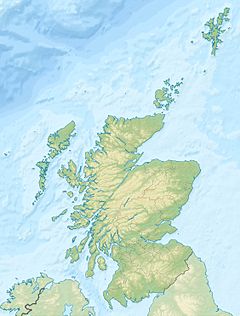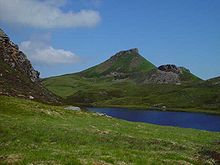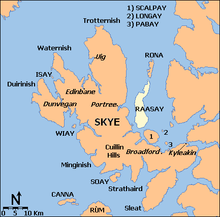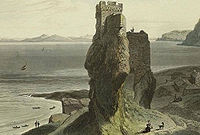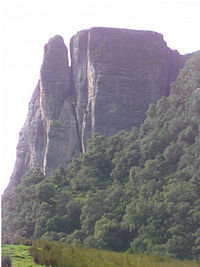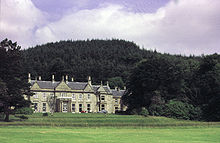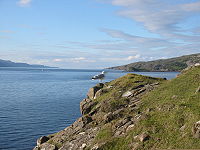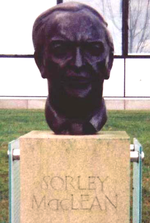- Raasay
-
Raasay Location Raasay shown within Scotland OS grid reference NG579395 Coordinates 57°24′N 6°02′W / 57.4°N 6.033°WCoordinates: 57°24′N 6°02′W / 57.4°N 6.033°W Names Gaelic name Ratharsair Pronunciation [rˠa.arˠs̪əɾʲ] (  listen)
listen)Norse name Raa-s-oy or Ross-oy, Rásey or Hrossey Meaning of name Old Norse for "roe deer island" or possibly "horse island" Area and summit Area 6,231 hectares (24.1 sq mi) Area rank 19 Highest elevation Dùn Caan 444 metres (1,457 ft) Population Population 192 Population rank 33 out of 97 Main settlement Inverarish Groupings Island group Skye Local Authority Highland 

References [1][2][3] If shown, area and population ranks are for all Scottish islands and all inhabited Scottish islands respectively. Population data is from 2001 census. Raasay (Scottish Gaelic: Ratharsair[4]) is an island between the Isle of Skye and the mainland of Scotland. It is separated from Skye by the Sound of Raasay and from Applecross by the Inner Sound. It is most famous for being the birthplace of the poet Sorley MacLean, an important figure in the Scottish literary renaissance.[5] Traditionally the home of Clan MacSween, the island was ruled by the MacLeods from the 16th to the 19th century. Subsequently a series of private landlords held title to the island, which is now largely in public ownership.[6] Raasay House, which was visited by James Boswell and Samuel Johnson in 1773, is now an outdoor centre.[7] Raasay means "Isle of the Roe Deer" and is home to an endemic subspecies of Bank Vole.[2]
Contents
Geology and geography
About 14 miles (23 km) north to south and 3 miles (4.8 km) east to west (at its widest), Raasay's terrain is varied. The highest point at 443 metres (1,453 ft) is Dùn Caan, an unusual, flat-topped peak. The island of Rona lies just off the north coast and the tidal islets of Eilean Fladday and Eilean Tigh are to the northwest. Other smaller surrounding islands are Eilean Aird nan Gobhar, Eilean an Inbhire, Holoman Island, Manish Island, Fraoch Eilean, Glas Eilean, Griana-sgeir and Eilean an Fhraoich. The main village of Inverarish is near the southwest coast.
Geologically interesting, the island is visited by many students engaged in mapping projects. The south is mainly Torridonian sandstone and shale; the north is grey-banded Archaean Lewisian gneiss and granulite with layers of gabbro, peridotite and anorthosite. There are also smaller outcrops of Jurassic oil shales and sandstones occasionally interspersed with limestone. The related ironstone beds contain low grade oolitic siderite and chamosite ores which were worked commercially in the early 20th century. Remaining reserves are estimated at 10 million tonnes. The seas to the east and west are very deep, large troughs having been created by the Skye icecap in the Pleistocene.[8]
Economy and culture
The primary employment is in tourism, working for the ferry company, crofting and fishing, or commuting to work on Skye. There is a primary school, but older students go to Portree via ferry and bus. A twenty-minute ferry ride connects the island with Sconser on Skye.
Sites of interest include the remains of a broch, the ruins of Brochel Castle, inscribed stones, the old manor of Raasay House, abandoned crofting communities, and many walking paths.
There is a shop/post office located in Inverarish. Accommodation is available at Borodale House, the Raasay Outdoor Centre (located in Borodale House due to the longtime closure of Raasay House),[9][10] at various B&Bs, and the Scottish Youth Hostels Association hostel, Creachan Cottage. There are significant numbers of incomers and holiday homes especially in the south of the island. This has helped to arrest the population decline from over 900 in 1803 to 194 in 2001. Some inhabitants belong to the Free Presbyterian Church of Scotland, which strictly observes the Sabbath. On Sundays there are no public services, the playground is closed and, until 2004, the ferry did not run.[11][12]
In early 2007 the Raasay Community Association signed a contract with a number of building contractors to construct a community centre, which hosted its first céilidh on May 29, 2010.[13][14][15] In 2008 construction began on a new £12 million ferry terminal at Churchton Bay, which was officially opened on 17 August 2010. Following the community buyout of Raasay House a £3.5M refurbishment is underway, leading to the temporary closure of the outdoor centre until 2009.[16][17] However, in the early hours of January 18, 2009 the building was severely damaged by fire.[18] Restoration work commenced in August 2010 but was suspended in November when the main contractor, ROK, went into administration.[19][20]
Flora and fauna
Raasay is home to the Raasay vole (Clethrionomys glareolus erica),[21] a subspecies of Bank Vole, which is darker and heavier than the mainland variety and found nowhere else in the world. It is possibly a survivor of a Scandinavian race. Murray (1973) states that a single specimen of a Pine Marten, otherwise missing from the Hebrides, was found on the island in 1971.[22] No other records for this species exist. Raasay is one of only four of the Inner Hebrides where Mountain Hares breed.[23] Raasay is regularly visited by White-tailed Sea Eagles and Golden Eagles and there are populations of Otter, Red Deer and European Rabbit (which were thoughtlessly introduced by the island's proprietor in the 19th century). Stoat and Weasel are found in small numbers, but Water Shrews, which were recorded in the 20th century but are now absent.[24] It also supports a rich variety of plants, including Red Broomrape, Dark Red Helleborine, Mountain Avens and numerous other saxifrages, orchids, alpines and ferns. The Carline Thistle (Carlina vulgaris) was apparently extant in the 1970s, but a recent survey found no evidence of its continued existence. There are several stands of mixed woodland.[2][25][26]
History
The spread of Scots culture from Dalriada north of Ardnamurchan is poorly understood and little is recorded of Raasay's early Christian period. The placename Kilmaluag suggests the presence of St Moluag in the late sixth century.[27]
15th to 17th century
Tradition has it that Clan MacSween originally held title to Raasay but there is no written record of this.[28] It is known that the island was ruled by the MacLeods from 1518 when Calum Garbh, younger son of the MacLeod Chief of Lewis was granted title.[2] Martin Martin visited towards the end of the 17th century and noted:
it has some wood on all the quarters of it, the whole is fitter for pasturage than cultivation, the ground being generally very unequal, but very well watered with rivulets and springs. There is a spring running down the face of a high rock on the east side of the isle; it petrifies into a white substance, of which very fine lime is made, and there is a great quantity of it. There is a quarry of good stone on the same side of the isle; there is abundance of caves on the west side, which serve to lodge several families, who for their convenience in grazing, fishing, &c., resort thither in the summer. On the west side, particularly near to the village Clachan, the shore abounds with smooth stones of different sizes, variegated all over. The same cattle, fowl, and fish are produced here that are found in the isle of Skye. There is a law observed by the natives that all their fishing lines must be of equal length, for the longest is always supposed to have best access to the fish, which would prove a disadvantage to such as might have shorter ones.
There are some forts in this isle, the highest is in the south end; it is a natural strength, and in form like the crown of a hat; it is called Dun-Cann, which the natives will needs have to be from one Canne, cousin to the king of Denmark. The other lies on the side, is an artificial fort, three stories high, and is called Castle Vreokle.[29]
Brochel Castle, as it is more commonly known, was built by the MacSweens in the 15th century on the north-east coast of Raasay. Latterly, it became a base for the MacLeod of Lewis's pirating activities prior to Calum Garbh's investiture there. The castle was inhabited until the death by drowning of the Chief Iain Garbh in 1671 and is now a ruin sitting atop a pinnacle. In the meantime the Macleods moved their seat to Raasay House at the south end of the island.[2][6]
18th century
Although Protestant, the MacLeods of Raasay supported Bonnie Prince Charlie in 1745. After the defeat at the Battle of Culloden, the Prince spent some time hiding from the British troops on Raasay[30] and as a consequence of the island's support for the Jacobite cause the original Raasay House and many dwellings were burnt down by government troops. In conversation with Malcolm MacLeod of Raasay during his short stay on the island the Prince confided that although his life on the run was hard, he would rather live that way for ten years than be captured as he feared assassination. He seemed less aware of the risks his supporters ran. The atrocities perpetrated in the aftermath of Culloden were a shock to him. Of Cumberland he said: "Surely that man who calls himself a duke and pretends to be so great a general cannot be guilty of such cruelties. I cannot believe it."[31]
In 1773 James Boswell and Samuel Johnson arrived on the island during their Hebridean tour. Johnson wrote:
Our reception exceeded our expectations. We found nothing but civility, elegance, and plenty. After the usual refreshments, and the usual conversation, the evening came upon us. The carpet was then rolled off the floor; the musician was called, and the whole company was invited to dance, nor did ever fairies trip with greater alacrity. The general air of festivity, which predominated in this place, so far remote from all those regions which the mind has been used to contemplate as the mansions of pleasure, struck the imagination with a delightful surprise, analogous to that which is felt at an unexpected emersion from darkness into light.
When it was time to sup, the dance ceased, and six and thirty persons sat down to two tables in the same room. After supper the ladies sung Erse songs, to which I listened as an English audience to an Italian opera, delighted with the sound of words which I did not understand.[32]
Boswell went exploring and described the island as follows:
Having resolved to explore the island of Rasay, which could be done only on foot, I last night obtained my fellow-traveller’s permission to leave him for a day, he being unable to take so hardy a walk. Old Mr Malcolm M’Cleod, who had obligingly promised to accompany me, was at my bedside between five and six. I sprang up immediately, and he and I, attended by two other gentlemen, traversed the country during the whole of this day. Though we had passed over not less than four-and-twenty miles of very rugged ground, and had a Highland dance on the top of Dùn Can, the highest mountain in the island, we returned in the evening not at all fatigued, and piqued ourselves at not being outdone at the nightly ball by our less active friends, who had remained at home.
My survey of Rasay did not furnish much which can interest my readers; I shall therefore put into as short a compass as I can, the observations upon it, which I find registered in my journal. It is about fifteen English miles long, and four broad. On the south side is the laird’s family seat, situated on a pleasing low spot. The old tower of three stories, mentioned by Martin, was taken down soon after 1746, and a modern house supplies its place. There are very good grass-fields and corn-lands about it, well dressed. I observed, however, hardly any inclosures, except a good garden plentifully stocked with vegetables, and strawberries, raspberries, currants, &c.[33]
19th and 20th centuries
In 1843 the last laird, John Macleod, was deep in debt and chose to emigrate to Tasmania[6] having sold Raasay for 35,000 guineas to George Rainy. After the failure of the potato harvests in the 1840s the new owner decided to convert as much arable land as possible to sheep farming. This required the removal of the islanders and his solution was to ban marriage. Several townships were cleared including Hallaig and Screapadal. Two boat loads of emigrants left for Australia in 1852 as a result and another 165 left for the same destination in 1865. The estate was then sold to Edward Wood and conflicts between the laird and the islanders grew as he decided to turn the island over to sporting purposes.[34] On 20 September 1862 the steamship Irishman ran aground on "Skernataid Rock" between Raasay and Scalpay. A 9.2 metres (30 ft) vessel Spindrift is also recorded as having become jammed under the ferry pier at the sound end of the island and broken in two by the rising tide at an unspecified date.[35]
The island was acquired in 1912 by Baird & Co. who opened the iron mine. A portion of the village served as a prisoner-of-war camp for Germans during the World War I, who were used to work the mine. The island was purchased by the government in 1922 after the mine closed. In 1949 The Forestry Commission was granted land bringing much-needed employment, and 1956 The North of Scotland Hydro-Electric Board delivered mains electricity to the island.[36] In the 1960s Raasay House and various other properties were purchased by Dr John Green, a resident of Sussex who visited the island only once and whose lack of interest in it earned him the sobriquet "Dr No". Having purchased the property for £8,000 he finally sold it to the Highlands and Islands Development Board in 1979 for £135,000.[2][6][37]
Population
Year 1780 1803 1841 1881 1891 1931 1961 1981 1991 2001 Population 400 + 900 + 676 532 489 377 223 152 163 194 Raasay has the lowest percentage of children of any populated Scottish island.[2] With 36% in the 2001 census there is still a relatively high density of Gaelic speakers (down from over 75% in 1901 and 1921).[38]
Culture and the arts
Piping tradition
John McKay, born on Raasay in 1767, was supported by the MacLeod Chief as the foremost island piper of his day and an inheritor of the MacCrimmon tradition. His son Angus published a pibroch collection and was the first piper to Queen Victoria.[6] The subsequent family members have emigrated from the island, and their direct descendent lives in Inveraray.
Sorley MacLean
The poet Sorley MacLean was born in Osgaig, a small crofting community on the west coast of the island; perhaps his most famous poem is about Hallaig, an abandoned community on the east coast. MacLean's writings often combine an ancient traditional awareness, with a modernist political outlook, in which Raasay, and the areas adjacent to it are frequently referenced. But while MacLean's work dwells on the brutality of war, of the Highland Clearances and modern exploitation, he also writes about nature. Thus, although the Clearances leave an empty landscape populated only by the ghosts of those evicted or forced to emigrate, "Time, the deer, is in the Wood of Hallaig".[39]
MacLean lived much of his life off the island, but some of his time was spent in nearby Sleat on Skye and Plockton on the neighbouring mainland.
Calum's Road
The two miles (3 km) of road between Brochel Castle and Arnish were built using hand-tools by Calum MacLeod BEM over ten years. Only when complete was the road surfaced by the local council; by then Calum and his wife were the last inhabitants of Arnish. Calum's Road has been commemorated in song by Capercaillie on their 1988 album The Blood is Strong and in a book by Roger Hutchinson.[40][41][42]
References
- Notes
- ^ General Register Office for Scotland (28 Nov 2003) Occasional Paper No 10: Statistics for Inhabited Islands. Retrieved 9 July 2007.
- ^ a b c d e f g Haswell-Smith, Hamish (2004). The Scottish Islands. Edinburgh: Canongate. pp. 161–166. ISBN 1841954543.
- ^ "Get-a Map" Ordnance Survey. Retrieved 3 March 2007.
- ^ Mac an Tàilleir, Iain, (2003) "Placenames P-Z" (pdf) Edinburgh. Pàrlamaid na h-Alba. Retrieved 8 June 2008.
- ^ Douglas Gifford, Douglas; Dunnigan, Sarah; MacGillivray, Alan: (Eds.) (2002) Scottish Literature: In English and Scots. Edinburgh University Press. Retrieved 2 June 2007.
- ^ a b c d e Keay & Keay (1994) Page 797.
- ^ "Welcome to Raasay House" Raasay Outdoor Centre. Retrieved 4 June 2007.
- ^ Gillen (2003) Page 176.
- ^ "Borodale House (formerly the Isle of Raasay Hotel)". isleofraasayhotel.co.uk Retrieved 25 May 2011.
- ^ "Raasay House". raasay-house.co.uk Retrieved 25 May 2011.
- ^ MacLeod (2004) Page 182.
- ^ "Sabbath ferry service sets sail" (2 May 2004) BBC News. Retrieved 28 October 2008.
- ^ "RCA - News: March 2007" Raasay Community Association. Retrieved 27 October 2008.
- ^ "Community Centre - Inverarish, Isle of Raasay (2007)" Dualchas Building Design. Retrieved 31 May 2010.
- ^ "Calum's Road" The Gambia Horse and Donkey Trust. Retrieved 31 May 2010.
- ^ "Work commences on Raasay Ferry Terminal" (7 March 2008) Highland Council. Retrieved 12 May 2008.
- ^ "Raasay Outdoor Centre" Raasay.com. Retrieved 12 May 2008.
- ^ "Blaze devastates historic isle house" The Scotsman. Retrieved 19 January 2009.
- ^ Ross, David (4 August 2010) "Restoration work starts on fire-ravaged Raasay House." Glasgow: The Herald.
- ^ "Rok boss tells of bid to buyout construction division". (17 November 2010) BBC News. Retrieved 25 May 2011.
- ^ "FUNET species list: Rodentia" funet.fi. Retrieved 12 April 2007.
- ^ Murray (1973) Pages 108–109. He states "The pine marten, which has been absent from the Hebrides for a hundred years, reappeared on Raasay in 1971, when a single specimen was identified beyond doubt". He attributes this to a 1972 report in The Scotsman by Alison Lambie.
- ^ Fraser Darling & Boyd (1969) Page 71.
- ^ Murray (1073) page 107 is quite clear that "water shrews are recorded only from Mull, Skye, and Raasay", but see recent records starting from 1986 at "Mammal Atlas" Highland Biological Recording Group. Retrieved 19 August 2009.
- ^ Slack, Alf "Flora" in Slesser (1970) Page 57.
- ^ For a comprehensive flora of the island see Bungard, Stephen J. (2009) "A Flora of Raasay and Rona" waitrose.com. Retrieved 19 August 2009.
- ^ Rixson (2001) Page 19.
- ^ MacLeod (2004) Page 17.
- ^ Martin, Martin (1703) A Voyage to St. Kilda in A Description of The Western Islands Of Scotland. [1] Retrieved 3 March 2007.
- ^ Murray (1966) Page 153.
- ^ Forster (1975) Page 169.
- ^ Johnson, Samuel (1775) A Journey to the Western Islands of Scotland. London. Chapman & Dodd. (1924 edition). Pages 85–86.
- ^ Boswell, James (1785) Journal of a Tour to the Hebrides with Samuel Johnson, LL.D: Sunday, 5th September. Retrieved 27 October 2008.
- ^ Cooper (1979) Pages 142–143.
- ^ Baird (1995) p. 234. Baird suggest "Skernataid Rock" may be Sgeir Thraid at NG628334
- ^ MacLeod (2004) Page 173.
- ^ MacLeod (2004) Pages 174–183.
- ^ Mac an Tàilleir, Iain (2004) 1901-2001 Gaelic in the Census (PowerPoint ) Linguae Celticae. Retrieved 1 June 2008.
- ^ "Hallaig by Sorley MacLean, translated by Seamus Heaney" (30 November 2002) guardian.co.uk Retrieved 27 October 2008.
- ^ "The Blood Is Strong" capercaillie.co.uk. Retrieved 27 October 2008.
- ^ "Calum's Road" (chord sequence) nigelgatherer.com. Retrieved 27 October 2008.
- ^ Hutchinson (2006)
- Bibliography
- Baird, Bob (1995) Shipwrecks of the West of Scotland. Glasgow. Nekton Books. ISBN 1897995024
- Cooper, Derek (1979), Road to the Isles: Travellers in the Hebrides 1770-1914, London: Routledge & Kegan Paul, ISBN 9780710002563
- Forster, Margaret (1975), The Rash Adventurer: The Rise and Fall of Charles Edward Stuart, St Albans: Panther, ISBN 9780586040829
- Fraser Darling, F; Boyd, J Morton (1969), Natural History in the Highlands and Islands, London: Collins, ISBN 9780002130929
- Gillen, Con (2003), Geology and landscapes of Scotland, Harpenden: Terra, ISBN 9781903544099
- Haswell-Smith, Hamish (2004). The Scottish Islands. Edinburgh: Canongate. ISBN 1841954543.
- Hutchinson, Roger (2006), Calum's Road, Edinburgh: Birlinn, ISBN 9781841584478
- Keay, John; Keay, Julia (1994), Collins Encyclopaedia of Scotland, London: HarperCollins, ISBN 9780002550826
- MacLeod, Norma (2004), Raasay: the island and its people, Edinburgh: Birlinn, ISBN 9781841582801
- Murray, W. H. (1966), The Hebrides, London: Heinemann, OCLC 4998389
- Murray, W. H. (1973), The Islands of Western Scotland, London: Eyre Methuen, ISBN 0413303802
- Rixson, Denis (2001), The Small Isles: Canna, Rum, Eigg and Muck, Edinburgh: Birlinn, ISBN 9781841581545
- Slesser, Malcolm (1970), The Island of Skye, Edinburgh: Scottish Mountaineering Trust, ISBN 9780901516268
Further reading
- Murray, C. W. & Birks, H. J. B. (2005) The Botanist in Skye and Adjacent Islands: An Annotated Check-list of the Vascular Plants of the Islands of Skye, Raasay, Rona, Rum, Eigg, Muck, Canna, Scarpay and Soay. Murray and Birks. ISBN 0-9548971-0-2
- Sharpe, Richard (1977/1982) Raasay A Study In Island History. London. Grant and Cutler. ISBN 0729301303
- Sharpe, Richard (1978) Raasay A Study In Island History Documents And Sources. London. Grant and Cutler. ISBN 0729300609
- Draper, Laurence and Pamela (1990) The Raasay Iron Mine. Dingwall. Laurence and Pamela Draper. ISBN 0951487000
- MacLean, Sorley (1954) Hallaig. Gairm magazine. Translation by Seamus Heaney (2002)
- Nicholson, John (2002) I Remember: Memories Of Raasay. Edinburgh. Birlinn.
- Stack, Prunella (1979) Island Quest. The Inner Hebrides. Collins/Harvill Press. London. ISBN 0002623234
External links
- Raasay Community Association
- Raasay Outdoor Centre (has photo galleries)
- Isle of Raasay Hotel (has photo galleries)
Skye / An t-Eilean Sgitheanach Main settlements Crofting townships
and settlementsAchachork · Aird of Sleat · Ardvasar · Armadale · Ashaig · Bernisdale · Bornesketaig · Boreraig · Borreraig · Borrodale · Borve · Bracadale · Breakish · Brogaig · Bualintur · Camastianavaig · Camuscross · Carbost, Loch Harport · Carbost, Portree · Claigan · Colbost · Drumfearn · Drynoch · Dunan · Duntulm · Edinbane · Elgol · Ellishadder · Eynort · Eyre · Fasach · Feorlig · Ferindonald · Fiskavaig · Flashader · Flodigarry · Galltrigill · Garafad · Geary · Gedintailor · Gillen · Glendale · Halistra · Harlosh · Heaste · Isleornsay · Kensaleyre · Kilbride · Kilmarie · Kilmore · Kilmuir · Kilvaxter · Kingsburgh · Kylerhea · Lealt · Lower Breakish · Luib · Milovaig · Ollach · Ose · Peinachorran · Portnalong · Ramasaig · Roag · Sconser · Skeabost · Sligachan · Staffin · Stein · Struan · Suladale · Talisker · Tarskavaig · Teangue · Torrin · Totaig · Tote · Treaslane · Trumpan · Uigshader · Ullinish · Upper BreakishMountains and hills Am Basteir · Beinn na Caillich · Blà Bheinn · Bruach na Frìthe · Clach Glas · Glamaig · Healabhal Bheag · Sgurr a' Ghreadaidh · Sgurr a' Mhadaidh · Sgurr Mhic Choinnich · Sgurr na Banachdich · Sgurr nan Gillean · Sgurr Dearg · Marsco · Quiraing/Meall na Suiramach · Sgurr Alasdair · The StorrHistory Armadale Castle · Battle of the Braes · Battle of the Spoiling Dyke · Caisteal Maol · Corriechatachan · Dùn Ringill · Dunvegan Castle · Fairy Flag · Flora MacDonald · Sir Rory Mor's Horn · Rubha an DùnainLocal culture Peninsulas Surrounding islands Ascrib Islands · Crowlin Islands · Eilean Bàn · Eilean Fladday · Eilean Mòr · Eilean Tigh · Eilean Trodday · Fladda-chùain · Harlosh Island · Isay · Lampay · Longay · Mingay · Oronsay · Pabay · Raasay · Scalpay · Rona · Soay · Staffin Island · Tarner Island · WiayInhabited islands of the Hebrides Inner Hebrides 
Outer Hebrides Baleshare · Barra · Benbecula · Berneray · Eriskay · Flodaigh · Fraoch-eilean · Great Bernera · Grimsay (North) · Grimsay (South) · Lewis and Harris · North Uist · Scalpay · South Uist · VatersayIslands of Scotland Northern Isles 
Hebrides Other Categories:- Islands of the Inner Hebrides
- Skye and Lochalsh
- Sites of Special Scientific Interest in Skye and Lochalsh
- Mines in Scotland
Wikimedia Foundation. 2010.

